Related Research Articles

Shoshoni, also written as Shoshoni-Gosiute and Shoshone, is a Numic language of the Uto-Aztecan family, spoken in the Western United States by the Shoshone people. Shoshoni is primarily spoken in the Great Basin, in areas of Wyoming, Utah, Nevada, and Idaho.
Tshangla is a Sino-Tibetan language of the Bodish branch closely related to the Tibetic languages. Tshangla is primarily spoken in Eastern Bhutan and acts as a lingua franca in the region; it is also spoken in the adjoining Tawang tract in the Indian state of Arunachal Pradesh and the Pemako region of Tibet. Tshangla is the principal pre-Tibetan language of Bhutan.

Gurung, also known as Tamu Kyi or Tamu Bhāṣā, is a Sino-Tibetan language spoken by the Gurung people of Nepal. The total number of all Gurung speakers in Nepal was 227,918 in 1991 and 325,622 in 2011.

Sherpa is a Tibetic language spoken in Nepal and the Indian state of Sikkim, mainly by the Sherpa. The majority speakers of the Sherpa language live in the Khumbu region of Nepal, spanning from the Chinese (Tibetan) border in the east to the Bhotekosi River in the west. About 200,000 speakers live in Nepal, some 20,000 in Sikkim (1997) and some 800 in Tibetan Autonomous Region (1994). Sherpa is a subject-object-verb (SOV) language. Sherpa is predominantly a spoken language, although it is occasionally written using either the Devanagari or Tibetan script.

Tamang is a term used to collectively refer to a dialect cluster spoken mainly in Nepal, Sikkim, West Bengal (Darjeeling) and North-Eastern India. It comprises Eastern Tamang, Northwestern Tamang, Southwestern Tamang, Eastern Gorkha Tamang, and Western Tamang. Lexical similarity between Eastern Tamang and other Tamang languages varies between 81% and 63%. For comparison, lexical similarity between Spanish and Portuguese, is estimated at 89%.
The Sikkimese language, also called Sikkimese, Bhutia, or Drenjongké, Dranjoke, Denjongka, Denzongpeke and Denzongke, belongs to the Tibeto-Burman languages. It is spoken by the Bhutia in Sikkim, India and in parts of Koshi, Nepal. It is the Official Language of Sikkim, India. The Sikkimese people refer to their own language as Drendzongké and their homeland as Drendzong. Up until 1975 Sikkimese was not a written language. After gaining Indian Statehood the language was introduced as a school subject in Sikkim and the written language was developed.
Tauya is a Rai Coast language spoken in the Ramu River valley, Madang Province, Papua New Guinea by approximately 350 people. The Linguistics Department at the University of Manitoba in Winnipeg, Canada, has Tauya language resources.

Northern Qiang is a Sino-Tibetan language of the Qiangic branch, more specifically falling under the Tibeto-Burman family. It is spoken by approximately 60,000 people in East Tibet, and in north-central Sichuan Province, China.

The Tarahumara language is a Mexican Indigenous language of the Uto-Aztecan language family spoken by around 70,000 Tarahumara (Rarámuri/Ralámuli) people in the state of Chihuahua, according to a 2002 census conducted by the government of Mexico.

Languages of Nepal, referred to as Nepalese languages in the country's constitution, are the languages having at least an ancient history or origin inside the sovereign territory of Nepal spoken by Nepalis. The 2011 national census listed 123 languages spoken as a mother tongue in Nepal. Most belong to the Indo-Aryan and Sino-Tibetan language families.
Pattani, also known as Manchad, is an endangered Sino-Tibetan language spoken in the Indian state of Himachal Pradesh.

Chamling is one of the Kirati languages spoken by the Chamling of Nepal, India and Bhutan. Alternate renderings and names include Chamling, Chamlinge and Rodong. It is closely related to the Bantawa and Puma languages of the Kiranti language family in eastern Nepal, and it belongs to the broader Sino-Tibetan language family. Chamling has SOV word order.

Yolmo (Hyolmo) or Helambu Sherpa, is a Tibeto-Burman language of the Hyolmo people of Nepal. Yolmo is spoken predominantly in the Helambu and Melamchi valleys in northern Nuwakot District and northwestern Sindhupalchowk District. Dialects are also spoken by smaller populations in Lamjung District and Ilam District and also in Ramecchap District. It is very similar to Kyirong Tibetan and less similar to Standard Tibetan and Sherpa. There are approximately 10,000 Yolmo speakers, although some dialects have larger populations than others.
The Kwaio language, or Koio, is spoken in the centre of Malaita Island in the Solomon Islands. It is spoken by about 13,000 people.

Kadu or Kado(Kadu:); is a Sino-Tibetan language of the Sal branch spoken in Sagaing Region, Myanmar by the Kadu people. Dialects are Settaw, Mawkhwin, and Mawteik [extinct], with 30,000 speakers total. Kadu is considered an endangered language, and is closely related to the Ganan and Sak languages.
Manang, also called Manangba, Manange, Manang Ke, Nyishang, Nyishangte and Nyishangba, is a Sino-Tibetan language spoken in Nepal. Native speakers refer to the language as ŋyeshaŋ, meaning 'our language'. Manang and its most closely related languages are often written as TGTM in literature, referring to Tamang, Gurung, Thakali, and Manangba, due to the high degree of similarity in the linguistic characteristics of the languages. The language is unwritten and almost solely spoken within the Manang District, leading it to be classified as threatened, with the number of speakers continuing to decline. Suspected reasons for the decline include parents not passing down the language to their children, in order to allow for what they see as more advanced communication with other groups of people, and thus gain more opportunities. Due to the proximity of the district to Tibet, as well as various globally widespread languages being introduced into the area, use of the native language is declining in favor of new languages, which are perceived to aid in the advancement of the people and region.

Humla Tibetan, also known as Humla Bhotiya, and Humli Tamang, is the Sino-Tibetan language of the Tibetan people of Humla district in Nepal.
Kathariya Tharu also known as Kathoriya Tharu is one of the Indo Aryan languages spoken by the Tharu people of Nepal and India. It is a language spoken in the Sudurpashchim Province of Nepal, particularly in the Kailali District, including areas like Bardagoriya, Bhajani, Ghodaghodi, Joshipur. Additionally, it is spoken in the Uttar Pradesh state of India, specifically in Bahraich and Lakhimpur Kheri districts near the Nepal border.
The Sonha language also known as Sonaha, Sunha, or Sunah is an Indo-Aryan spoken in Lumbini Province, specifically in Bardiya District, covering Geruwa and Rajapur municipalities. It is also spoken in Sudurpashchim Province, particularly in Kanchanpur District and Bhimdatta of Nepal. Sonha exhibits linguistic similarities with Awadhi, with reported lexical similarities of 69% with Rana Tharu, 73% with Kathariya Tharu, and 72% with Dangaura Tharu. Notably, Sonha and Kathoriya serve as a lexical bridge connecting Rana and Dangaura varieties of Tharu.
Eastern Tamang is a Tibeto-Burman language of the Sino-Tibetan language family. It is spoken in mainly in Bagmati and Koshi provinces of Nepal as well as the states of Arunachal Pradesh, West Bengal (Darjeeling), and Sikkim in India by the Tamang people.
References
- ↑ Western Tamang at Ethnologue (26th ed., 2023)

- 1 2 "Western Tamang". Ethnologue. Retrieved December 26, 2023.
- ↑ Dan Raj Regmi and Ambika Regmi. 2018. A Grammar of Western Tamang. (Languages of the World/Materials, 511.) München: LINCOM. 160pp.
- ↑ Hale, Austin. 1973. Clause, sentence, and discourse patterns in selected languages of Nepal 4: Word lists. (40:4.) Summer Institute of Linguistics: Publications in Linguistics. 219pp.
- ↑ "Western Magar". Ethnologue. Retrieved December 25, 2023.